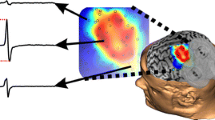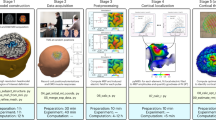Abstract
Cortical representation maps derived by transcranial magnetic stimulation (TMS) are often used, inter alia, in studying the plasticity of the brain. Parameters such as map area, map volume, optimal stimulation site and centre of gravity are commonly used to quantify changes in the topography of the motor cortex. However, reports on the stability of these parameters over time has not been conclusive. In the present study, the areas of the scalp from which responses were evoked from corticospinal cells projecting to three intrinsic hand muscles were systematically mapped with TMS at intervals of 24 hours, one week and two weeks from eight normal subjects. The area, "volume" and centre of gravity of these maps did not change significantly over this period. It is concluded that mapping with TMS is suitable for studies which aim to study the effect of various interventions on the cortical representation of individual muscles in human subjects.
Similar content being viewed by others
References
Brasil-Neto, J.P., McShane, L.M., Fuhr, P., Hallett, M. and Cohen, L.G. Topographic mapping of the human motor cortex with magnetic stimulation: factors affecting accuracy and reproducibility. Electroencephalogr. Clin. Neurophysiol., 1992, 85: 9–16.
Byrnes, M.L., Thickbroom, G.W., Wilson, S.A., Sacco, P., Shipman, J.M., Stell, R. and Mastaglia, F.L. The corticomotor representation of upper limb muscles in writer's cramp and changes following botulinum toxin injection. Brain, 1998, 121: 977–988.
Cohen, L.G., Ziemann, U., Chen, R., Classen, J., Hallet, M., Gerloff, C. and Butefisch, C. Studies of neuroplasticity with transcranial magnetic stimulation. J. Clin. Neurophysiol., 1998, 5: 305–324.
Cracco, R.Q., Cracco, J.B., Maccabee, P.J. and Amassian, V.E. Cerebral function revealed by transcranial magnetic stimulation. J. Neurosci. Meth., 1999, 89: 209–219.
Cramer, S.C. and Bastings, E.P. Mapping clinically relevant plasticity after stroke. Neuropharmacol., 2000, 39: 842–851.
Hamdy, S., Rothwell, J.C., Aziz, Q., Singh, K.D. and Thompson, D.G. Long-term reorganization of human motor cortex driven by short-term sensory stimulation. Nature Neurosci., 1998, 1: 64–68.
Levy, W.J., Amassian, V.E., Schmid, U.D. and Jungreis, C. Mapping of motor cortex gyral sites non-invasively by transcranial magnetic stimulation in normal subjects and patients. Electroencephalogr. Clin. Neurophysiol. Suppl., 1991, 43: 51–75.
Liepert, J. TMS mapping studies in peripheral and central lesions. Electroencephalogr. Clin. Neurophysiol. Suppl., 1999, 51: 151–156.
Miranda, P.C., de Carvalho, M., Conceicao, I., Sales-Luis, M.L. and Ducla-Soares, E. A new method for reproducible coil positioning in transcranial magnetic stimul ation mapping. Electroencephalogr. Clin. Neurophysiol., 1997, 105: 116–123.
Mortifee, P., Stewart, H., Schulzer, M. and Eisen, M. Reliability of transcranial magnetic stimulation for mapping the human motor cortex. Electroencephalogr. Clin. Neurophysiol. 1994, 93: 131–137.
Pascual-Leone, A., Tarazona, F. and Catala, M.D. Applications of transcranial magnetic stimulation in studies in motor learning. Electroencephalogr. Clin. Neurophysiol. Suppl., 1999, 51: 157–161.
Portney, L.G. and Watkins, M.P. Foundations of clinical research: applications to practice. Prentice Hall Inc., NJ, 2000: 427–451.
Ridding, M.C., Mckay, D.R., Thompson, P.D. and Miles, T.S. Changes in corticomotor representations induced by prolonged peripheral nerve stimulation in humans. Clin. Neurophysiol., 2001, 112: 1461–1469.
Thickbroom, G.W., Sammut, R. and Mastaglia, F. L. Magnetic stimulation mapping of motor cortex: factors contributing to map area. Electroencephalogr. Clin. Neurophysiol., 1998, 108: 79–84.
Thickbroom, G.W., Byrnes, M.L. and Mastaglia, F.L. Amodel of the effect of MEP amplitude variation on the accuracy of TMS mapping. Clin. Neurophysiol., 1999, 110: 941–943.
Wassermann, E.M., McShane, L.M., Hallet, M. and Cohen, L.G. Non-invasive mapping of muscle representations inhuman motor cortex. Electroencephalogr. Clin. Neurophysiol., 1992, 85: 1–8.
Wilson, S.A., Thickbroom, G.W. and Mastaglia, F.L. Transcranial magnetic stimulation of the motor cortex in normal subjects. The representation of two intrinsic hand muscles. J. Neurol. Sci., 1993, 118: 134–144.
Author information
Authors and Affiliations
Rights and permissions
About this article
Cite this article
Uy, J., Ridding, M.C. & Miles, T.S. Stability of Maps of Human Motor Cortex Made with Transcranial Magnetic Stimulation. Brain Topogr 14, 293–297 (2002). https://doi.org/10.1023/A:1015752711146
Issue Date:
DOI: https://doi.org/10.1023/A:1015752711146




